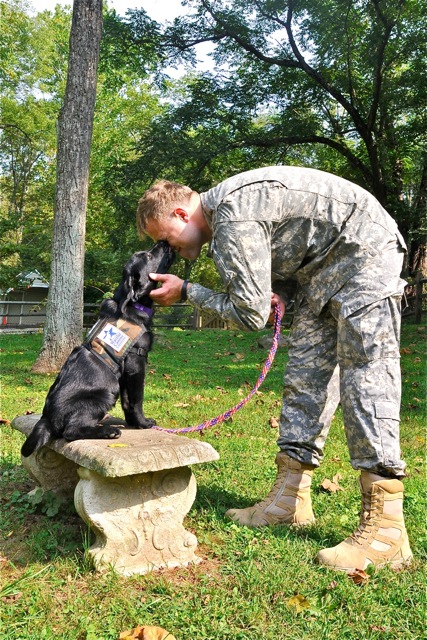Rick Yount, Founder and Executive Director, Warrior Canine Connection
What is it about training a service dog for a fellow Veteran that makes it such an effective therapy for military Service Members and Veterans who are battling post-traumatic stress, or dealing with the effects of a mild traumatic brain injury received during deployment? The answers – which are as multi-faceted as the conditions themselves – speak to both the strength of the Warrior Ethos and the incredible capacity of dogs to bond with and heal their human counterparts in surprising ways.
Many Veterans suffering from combat stress are reluctant to engage in therapy for their symptoms. However, they volunteer readily when offered the chance to train a service dog for one of their brothers or sisters in arms. In doing so, they are able to address their symptoms of post-traumatic stress disorder (PTSD) and traumatic brain injury (TBI). PTSD symptoms fall into three broad categories: re-experiencing, avoidance/numbing and increased arousal. Here’s how training our service dogs has a lasting, positive effect on the Warriors who train them.


Re-Experiencing
Procedures used in training Warrior Canine Connection (WCC) service dogs require the Warrior trainer to focus on the dog’s “here and now” point of view to recognize the “teachable moments” when instruction will be most effectively processed and retained. The presence of the dog during a stressful situation or encounter changes the context of the arousal event and anchors the trainer in the present, reminding the service members or veterans that they are no longer in dangerous circumstances. If the Warrior trainer does experience a trigger for symptoms, the presence of the dog can lower anxiety levels.
Avoidance and Numbing
Training a service dog requires the dog to be carefully exposed to a wide range of experiences in the community. This creates a need for Service Members with PTSD to challenge their impulses to isolate and avoid those same environments that the dogs must learn to tolerate. Dogs are natural social lubricants and so it is nearly impossible for the trainer to isolate from other people during this part of the training. Interactions with others in the company of the dogs have been reported to be less threatening, since the focus of the interaction is on the dog and the training.
In order to shape the behavior of a service dog, the trainer must also connect successfully with the dog. Warrior trainers with PTSD must overcome their emotional and affective numbness in order to heighten their tone of voice, bodily movements and capacity for patience in order to deliver their commands with positive, assertive clarity of intention and confidence. In doing this, trainers soon discover they can earn their dog’s attention and best guide them to the correct response.
The dog’s success must then be rewarded with emotionally based praise. This WCC training technique allows the trainers to experience rewarding positive emotional stimulation and social feedback. The basic daily needs of a service dog involve structured activities that also bring the trainer and dog into the kind of close nurturing contact that further creates a behavioral and psychological antidote to social avoidance.



Arousal
Service dogs, by nature, should be responsive to human emotions and needs. Their sensitivity to and reflection of their trainer’s emotional state provides immediate and accurate measures of the trainer’s projected emotion. This also challenges the trainer to overcome his or her tendency for startle reactions in order to relay a sense of security and positive feedback when their young dogs are faced with environmental challenges such a loud siren and approach by strangers.
Warrior Canine Connection service dogs are also bred to be affectionate and have a low-arousal temperament that puts their Warrior trainers “at ease.” With these dogs at their sides, WCC trainers have decreased anxiety and increased social competence. The training improves the ability to shift out of their hyper-vigilant, defensive mode into a relaxed state that makes them ready and able to connect with others.
 We hear the reports of the large number of our nation’s Warriors who are returning from their deployments with post-traumatic stress and mild traumatic brain injury. But there is good news for them on the home front, in the form of a healing mission based on the Warrior Ethos and the power of the human-animal bond.
We hear the reports of the large number of our nation’s Warriors who are returning from their deployments with post-traumatic stress and mild traumatic brain injury. But there is good news for them on the home front, in the form of a healing mission based on the Warrior Ethos and the power of the human-animal bond.
It starts with an effective dog training philosophy that is based on the creation of strong bonds. It stresses positive methods of shaping behaviors. And it requires a mastering of the patience required to train a service dog. Together, these requirements help Warriors who are healing from post-traumatic stress and traumatic brain injury to regain control of their emotions, focus their attention, and improve their social skills and overall sense of wellbeing.
Warrior Canine Connection conducts Warrior trainer programs and provides highly trained, purpose-bred Golden and Labrador Retrievers to Veterans with disabilities at no charge. The 501(c)3 charitable organization is accomplishes this through financial support — through July 2, 2015, Warrior Canine Connection is participating in the Veterans Charity Challenge 3 on Crowdrise. You can learn more about the organization and how to help at warriorcanineconnection.org.


